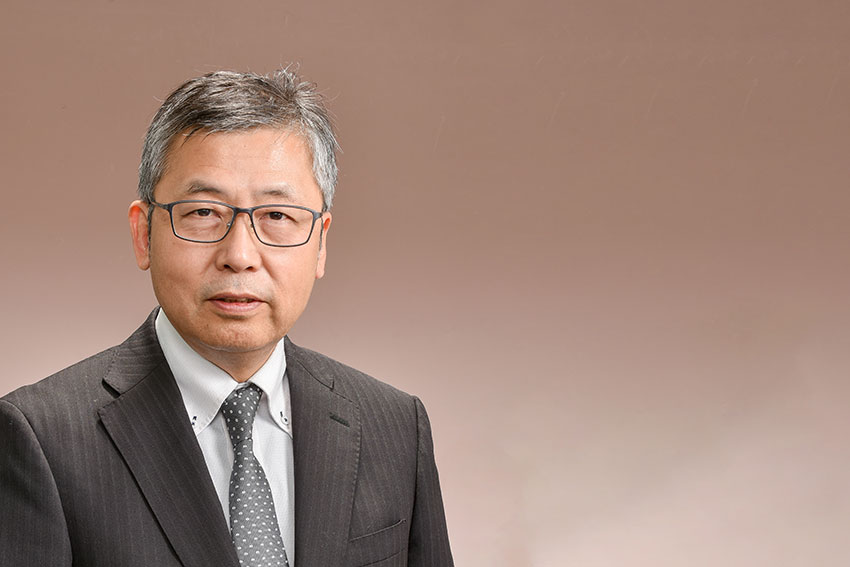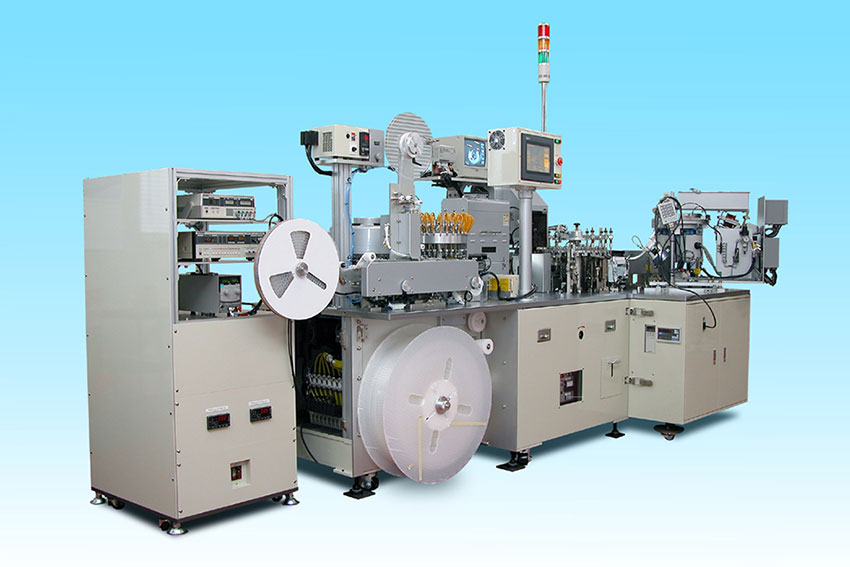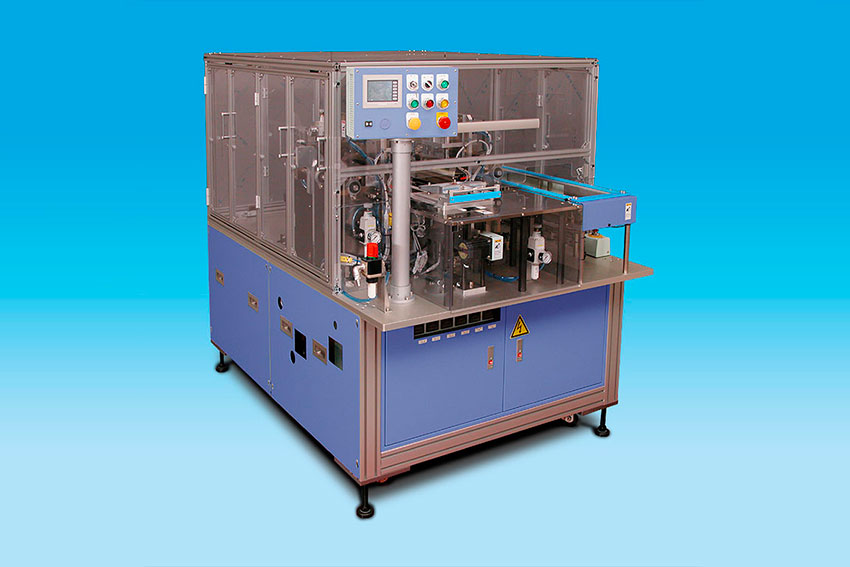The world’s leading company for tantalum capacitor manufacturing equipment, Hi Mecha President Chihiro Yokoyama sat down with the Worldfolio to discuss the latest developments in the Yamagata headquartered company

When it comes to high-mix-low-volume equipment and components we find that many Japanese corporations still retain very large market shares or technical leadership. How does Hi-Mecha face this price competition and what allows your firm to remain competitive in the global market?
It is true that Japanese companies are facing very stiff price competition from all around the world, and in our case, all of our products are made to order. We don’t really have a series of products, but instead, our products are more bespoke and different from one another. First, an inquiry comes from the customer, and then we evolve that and draw up a rough design plan. Next, we will do the R&D and submit the estimate to the customer. The cost here becomes the issue you’ve mentioned, and it comes down to whether the customer is willing to accept the cost or not. The costliest part of the breakdown is the R&D, and that is because if you want to design and create something from scratch it requires a lot of time and investment. The customer’s initial investment in a completely new solution may be high, however, we do have the ability to customize and tailor already designed products to fit their needs if required.
The company has a strong point obviously, and that strong point is in tantalum capacitor manufacturing equipment. This strong point puts us in a position where we are not easily replaced, and we do things that other companies cannot. Thus, we find that customers are approaching us to purchase tantalum capacitor manufacturing equipment despite the cost.
It is really a case-by-case basis, because sometimes we are losing out to chip manufacturing companies that are coming up and being very price competitive, however, we do have a strong point and can provide very high-quality products that no other manufacturers can make.
These days it is very difficult to keep intellectual property rights because of China and similar countries. We are still the number one company worldwide for tantalum capacitor manufacturing equipment, however, we are finding recently that there are some Chinese companies that have purchased our equipment in the past and are now trying to release copycat products. Of course, these are competitive companies, but we don’t consider them on the same maturity level as Hi-Mecha. This comes down to these companies not making as big an initial investment in the equipment that we have, and in fact, their investment only totals around 10% of the investments that Hi-Mecha has made in the modernization of our equipment. China is having a hard time catching up and I think this is because they are smaller local players that to be completely honest, are not exactly playing fair.
This isn’t anything new to us, however, and we saw this kind of copycat activity 25 years ago when we first introduced tantalum capacitor manufacturing to China. We also saw it with lithium-ion battery manufacturing equipment which saw an introduction to China and Korea 25 years ago by a company in Korea. A local player in Korea actually copied their product, so we can see lessons throughout modern history on how difficult it is to retain intellectual property rights on a product. Copycats, especially in China, will always find a way to copy. This is where we stand right now and we are trying to maintain our strong position in what promises we can keep to our customers. The one thing we can say is that the level of high quality and preciseness here in Japan is very different from that in China.

One of the main Capacitor Assembly equipment
Your company creates a series of sealing equipment for lithium-ion battery production. Can you tell us how your equipment helps make the production and transportation of lithium-ion batteries safer?
From a safety point of view, our lithium-ion battery manufacturing equipment is designed to increase the safety level and is made to avoid these kinds of explosions and accidents. It is very important to talk to the customers in this aspect, and we actually pick out the material with the customers so that they can decide what is best for them. It’s almost like a negotiation process that kicks off the initial stages of collaboration.
Of course with this kind of equipment welding is needed, and it is very crucial to keep the particles or the metal dust from contamination, and the whole process must be done in a sort of clean room environment. Keeping that cell away from contamination is very important not only for the function of the battery but also for the safety of the workers. As a Manufacturer, we have incorporated such safety measures into our equipment and are closely monitored by our customers to avoid any kind of accidents during the whole process.
What are your expectations for the lithium-ion battery market for your equipment, and are you expecting big growth?
Our market expectations are very optimistic with all the things that have been happening in the automotive sector. With the electrification of vehicles being pushed to the forefront, we are looking at what is happening in the market and taking stock of opportunities. The batteries themselves are high capacity and the expectations from car makers are for mass production of those batteries, and unfortunately, Hi-Mecha is not on that kind of mass production scale. Our production capacity is not at the level of mass production, and if demand for mass production comes in we would not be able to comply. For that sake, we are introducing our products as a niche market, and a lower scale of production.
To give you an example, we have already introduced our lithium-ion battery manufacturing equipment to a certain company’s large-scale automotive battery factory. If you visit there you will see a very long line of production, and some parts of the assembly line come from Hi-Mecha.
This order didn’t come directly from that company itself, but rather through an intermediary company that placed an order for Hi-Mecha equipment.
Hi-Mecha is the world’s leading company for tantalum capacitor manufacturing equipment. Could you tell us a little more about the machines that you manufacture and what industries they cater to?
Tantalum capacitors are widely used in notebooks and Apple products are quite famous for using these capacitors too. It is because they are more reliable and can operate longer compared to, say conventional capacitors like aluminum. Of course, data centers and servers use them, and customers there are very keen to find more viable solutions that are going to result in long life spans for their equipment. Basically, we are finding a use for them in places where you find a lot of data processing, so not hard disks, but rather silicone disks. Currently, a large amount of server equipment is installed at high density in data centers, and many polymer Ta capacitors are used on CPU boards and SSDs. The reason why polymer Ta capacitors are used is that they can store a large amount of electric charge even though they are only about 1mm high, so they are highly valued for their ability to instantaneously supply the electrical energy required by high-performance semiconductor chips. This trend is becoming a global trend. These days we all live in a digital society, and we all have data processing needs. This industry right now is crunching a lot of data and we are looking very optimistically for opportunities for us to really capture a good market share. The production capacity we have been outputting is currently trending up 7% year on year, which is fantastic news. We have very exciting times ahead.
The semiconductor business right now is seeing some very interesting changes, especially since the advent of COVID-19, which has caused chip shortages all around the world. We know that your company makes storage and inspection equipment for semiconductor production. Could you tell us what are some of your expectations for this business and how do you plan to leverage this growth?
Yes, of course, we are analyzing what is happening in the industry right now, and honestly, it is quite essential as we are related to semiconductor manufacturing. We handle the inspection equipment, which again is custom-made and personalized. As long as customers approach us with a request, then we will continue to create equipment that meets their specifications. As you have alluded to, the whole industry is demanding more and as manufacturers, we are always happy to introduce more products and satisfy customers' needs. We definitely felt a difference in what has been happening for the past several years, and some companies are shifting from their traditional business to producing semiconductors or to some extent semiconductor-related products. I think however that this is a good sign for the industry and something to look forward to.

Li-ion battery Packaging(Sealing) machine
The development of semiconductors has been dictated a lot by the trend of miniaturization, and Moore’s Law says that every two years the number of transistors in integrated circuits doubles. Just five years ago the minimum size was 7nm, but now IBM has launched a 2nm chip just a few months ago. With this miniaturization trend more power is able to be realized, but with more power comes more heat in the circuit. As a manufacturer of inspection devices and tantalum capacitors that are used in these circuits, how are you adapting to this trend towards miniaturization in your products?
It requires verification, and first I will say that this trend has been prevalent for a few years now. Even in tantalum capacitors, if you look back 20 years ago the size was quite big, but due to the market demands dictating the evolution of the products these capacitors are at one time down to as small as 0.5mm in height and 1mm in length.
Currently, the mainstream is a low-profile, high-capacity type with a height of 1 mm, a width of 4 mm, and a length of 7 mm, which can supply the necessary power to a semiconductor chip that requires a large amount of power.
Miniaturization and low profile hasn’t just occurred in semiconductors, but electronics at large, and we are seeing industry-wide demands for smaller and low profile products. Our business in the semiconductor industry are not that high, so while inquiries are coming in, they are not to the level we get for our tantalum capacitor equipment. Despite this however there really is a push from customers to increase the capacity and decrease the size and height, and this is coming from both industries.
It is also a fact that ceramic capacitors are replacing small Ta capacitors as their capacitance becomes higher. However, as mentioned earlier, Ta capacitors are still used in places where high capacitance is required despite their low profile, and this number continues to increase. We intend to keep both feet firmly planted on the products we have now.
Your company started off by welding dissimilar materials together and based on that experience you have been able to expand into welding equipment, lithium-ion battery equipment, and of course tantalum capacitor equipment. How does your expertise in welding dissimilar materials allow you to evolve into all these other segments and markets?
That is true, and we have been doing these kinds of activities since the beginning. I guess it can be considered the business of the founding fathers and the first generation of Hi-Mecha. Actually, the company was founded by workers with engineering backgrounds, and they came from another capacitor manufacturer. They had expertise in technical things and how to make things right, and that is why they decided to spin off and start their own company. That leads to the introduction of the capacitor welding machine series in the late 1970s, and everything else is history. This welding technology became the core from which we expanded to many other areas.
When you produce a Ta capacitor there are two points of welding, and one of them is considered very important and is called the “crucial welding spot.” This is basically the process of welding capacitor elements onto a Leadframe and is a very important process that contributes to the high performance of capacitors. If it isn’t welded correctly the entire capacitor will break down or malfunction so you can see how vital this welding point is. Our business really came from this welding experience and production capacity, and from this our business has grown over the 50 years of the company’s existence.
When you enter a new sector or make a new machine, how important are partnerships to your firm, and are you currently looking for partners?
Partnerships are very important in any business, especially in new approaches that our company doesn’t have expertise in or no connections in. Hi-Mecha already has experience with this through working with trade houses, with those sogo shosha widely acting as a way to introduce the product to potential customers. Historically we have a long history of working with these trade houses, particularly with semiconductor equipment and tantalum equipment.
When we entered the battery field, our approach was new and fresh: we partnered with someone who had spun off from a company that manufactured batteries and started his own R&D company. The hope then was that through our equipment and his expertise we would be able to introducing some excellent lithium-ion-based products to the Asian markets. It is actually controversial at the time because traditionally we have never really done sales by ourselves in certain area of business, and rather opted to use trade houses to make deals. However, at present, the direction is to conduct direct transactions as much as possible.
As a custom-made company, a lot of your production comes from here in Japan. What are the advantages of keeping your manufacturing domestic and how do remain resolute against global macroeconomic factors affecting your company currently like the yen depreciation?
It is definitely a big plus having the procurement of parts domestically, and the Japanese market is always going to be an advantage for the company. Most of the parts needed for our equipment are procured locally, and only a small amount is procured from China. These parts are manufactured at lower prices that cannot be realized domestically. Honestly speaking, however, we have been recently reconsidering this situation due to the depreciation of JPY and if this trend continues it won’t really make sense to procure from China.
Could you tell us a bit more about your international strategy and what are some of the key markets that you believe have the highest growth potential in the future?
Although 80% of Hi-MECHA's business comes from customers in overseas markets, the equipment we provide was originally intended for domestic companies. At some point we expanded our business to other Asian countries. This was in response to customer expansion overseas and the need for localized production facilities.
The other 20% is from the domestic market and others that are not Japanese-related customers. We do have a sales office in China and sales are done there by local managers. Additionally, we are trying to take a proactive approach to sales in North America and Israel by introducing our products through inquiries we have received in those regions. It is not like we are targeting one particular area, because our products are so customized and personalized, rather we will expand to areas if the inquiries demand it. We would be happy to introduce our products anywhere in the world that needs them.
Imagine a scenario where in 10 years' time we come back and have this interview all over again for your 60th anniversary. Could you tell us what you would like to have achieved by that date? What kind of personal goals or ambitions would you like to share with us then?
We need to continue to utilize our strengths, and as an R & D company with tailored made solutions, we must always meet the needs of the customers from inquiry to final product. This is the basic principle in which we operate, and it will not change in 10 years. The company itself isn’t necessarily oriented towards lofty financial goals. Of course, we do like being profitable, honestly who doesn’t, but our main goal isn’t that. Customers are the main goal here, and our company’s vision is all about bringing joy and happiness to those customers to the fullest extent possible. This has been our aim ever since our establishment 50 years ago and during that time this goal has never changed.
The average age of our employees' shifts from year to year as older workers retire and younger employees join us to take their place. Keeping employees happy and fulfilled is key to sustaining the company in that sense. I think the key word here is sustainability, not only to the employees, but the customers and the business itself.
0 COMMENTS